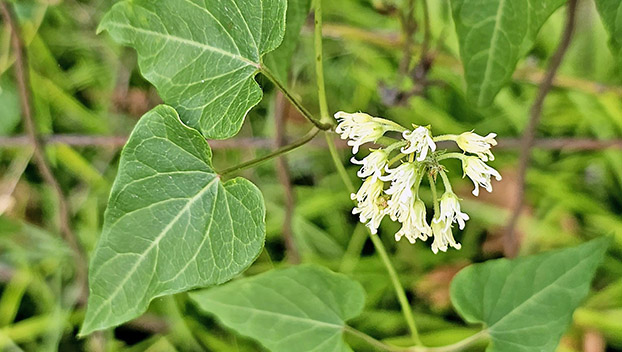Mother Nature’s Garden: Honeyvine: Friend or Foe
Published 12:47 pm Saturday, September 2, 2023

- Honeyvine is a high value plant for both larval and adult monarch butterflies.
|
Getting your Trinity Audio player ready...
|
Several days ago, I took a very early morning walk through my neighborhood because I was hoping to avoid the heat while still getting a bit of exercise. Just as I rounded the corner by a neighbor’s house, I noticed a vine growing on their old fence. At first, I thought it was a bindweed, but it wasn’t. It was Cynanchum laeve, commonly called honeyvine or sandvine, a new find for me. Honeyvine is one of those plants that’s been reclassified several times. It’s a native member of the Dogbane Family and a close relative of common milkweed.
Honeyvine is a non-woody perennial vine that twines around fences and over nearby vegetation for as much as 15 feet. It has shiny light green to greenish-red stems and opposite heart-shaped leaves that don’t produce a milky sap, but do contain a bitter substance that makes them unattractive to mammalian herbivores.
In mid to late summer, honeyvine has clusters of small white flowers in the leaf axils. They have a distinctive scent of honey and are pollinated primarily by solitary bees. Fertilized flowers are followed by smooth 4-inch-long follicles (a dry fruit formed from one carpel that contains one or more seeds) that change color from green to reddish green to brown. After maturing, the follicles split and release seeds with large tufts of white hairs, which enable the seeds to float quite far even on light breezes, thus establishing new colonies.
Trending
Because honeyvine spreads both by the dispersal of seeds and the formation of clonal colonies, it can be quite an assertive plant that’s a nuisance for some crops and isn’t easily incorporated into the home garden. Nevertheless, honeyvine is a high value plant for monarch butterflies because it is both a host for caterpillars and a source of nectar for the butterflies. A 2005 study by Yeargan and Allard comparing the value of common milkweed and honeyvine found that monarch larvae developed faster on honeyvine.
Honeyvine isn’t a well-behaved native. When I got home from my walk, I found several honeyvine plants running rampant through a perennial bed that needed serious weeding. Nevertheless, it’s a valuable native. And, oh, the fragrance!
Dr. Cynthia Wood is a master gardener who writes two columns for The Herald. Her email address is cynthia.crewe23930@gmail.com.





